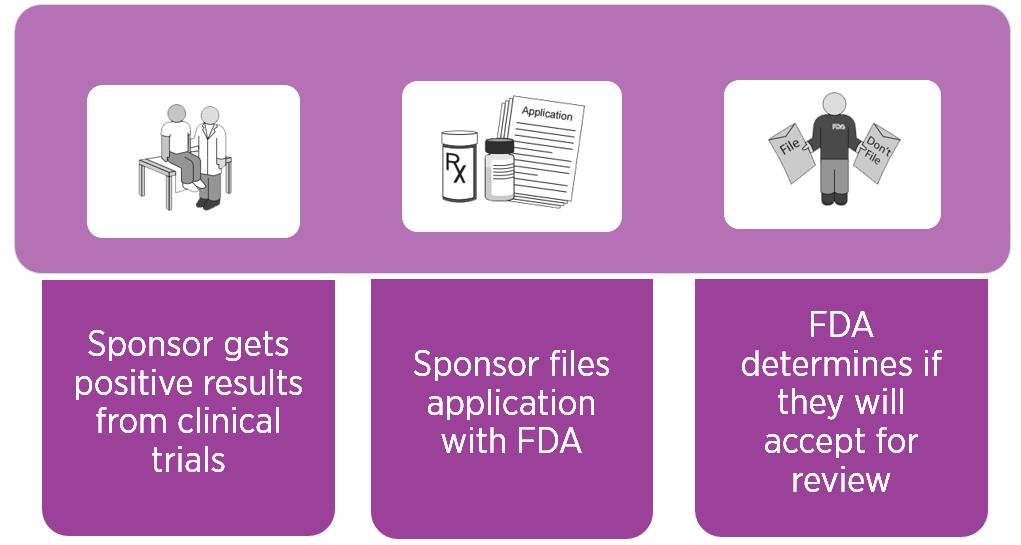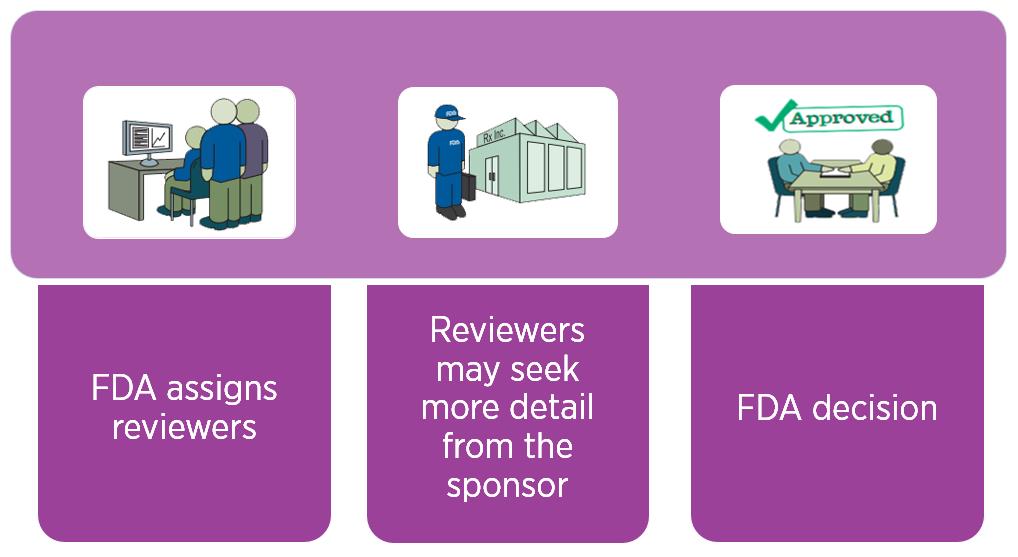
The Food and Drug Administration (FDA) is the agency charged by the US government to ensure that public health is protected through the control of food and drugs marketed in the United States. Within the FDA is the Center for Drug Evaluation and Research (CDER) who are responsible for reviewing new drug applications submitted for marketing approval. A similar agency, CBER, reviews applications for therapeutics that are of a biological nature, such as protein antibodies, gene therapies or stem cell treatments. The FDA and its internal groups, CDER/CBER, are in place to ensure that companies are marketing drugs that are safe, effective and are manufactured consistently. Robert Goldstein, Vice President at the ALS Therapy Development Institute, recently led a webinar on the topic of how drugs get approved in the United States. The following piece recaps that webinar, which can be listened to in full here.
At ALS TDI we make an effort to host webinars that are educational and relevant to people living with ALS today and their families. We decided to host this particular webinar for the following reasons:
- The FDA recently approved the first drug for ALS in 20 years, Radicava, and there are many more drugs in the clinical trial pipeline at the moment so it’s important to know what to expect
- The FDA and the approval process is often brought up when discussing issues such as the Right to Try and Compassionate Use which are extremely prevalent issues today
- There is some misinformation about the FDA and what its role is in clinical trials and approving new therapies
- The FDA recently published a guidance document on how it feels clinical trials in ALS should be done.
How does a drug get to the FDA for Review?

The first step towards drug approval is identifying a potential treatment and rigorously testing it. This is done through pre-clinical research and clinical trials in humans. Before a drug can be tested in people, the company sponsoring the drug must file an Investigational New Drug (IND) Application with the FDA. This outlines the early plans for clinical investigation into the drug and presents the companies findings on the drug from preclinical research. The FDA must be convinced by the information in this application that the proposed treatment will not put humans at unreasonable risk. Following its approval the company will commence clinical trials to test for safety, tolerability and later, efficacy. There are usually three phases of clinical trials but there are often further confirmatory and follow up studies if necessary. It is important to note that there are no “standard” clinical trials for ALS but the FDA have recently issued a draft guidance in an effort to let drug developers and others know how they think clinical trials in ALS should be run. The document is traditional in its thinking regarding how clinical trials should be conducted.
The ALS Therapy Development Institute strongly encourages people with ALS, and others to comment on the Draft Guidance. This is the first one of these such guidance's for industry that has been put together by the FDA. It will likely modified based on community input, as new endpoints are developed, as new biomarkers are validated, as innovative trial designs are organized and brought forward as well as when new treatments are approved which may impact how clinical trials are done altogether. Community advocacy and input to the FDA is crucial now and in the future on how clinical research studies and trials can be run in people with ALS. Comments can be submitted here.
(The above paragraph was edited April 9, 2018)
It is also important to note the role that the FDA plays in trial design. There is a no standard ALS clinical trial design. Each company investigating a treatment for ALS proposes a series of endpoints to the FDA to be explored in their trials. Endpoints are the specific ways in which the company will answer questions about safety, tolerability, and later, efficacy. For example, an endpoint in a safety trial may be “number of serious adverse events.” That endpoint would measure the number of series adverse events in the treatment group vs. the placebo group. Most trials will have one or two primary endpoints as well as several secondary endpoints.
The company can, and should, have a number of meetings with the FDA throughout the course of pre-clinical and clinical research to help them best select the endpoints to be used and develop methods to determine if they are met. Some of the most common meetings to have are 1) before an IND application is filed, 2) at the end of phase 2 and before and 3) after the New Drug Application (NDA) is filed. It is often during these meetings that the FDA may discuss options to pursue the granting of special designation to a potential therapy. The three main designations include
Once a company has completed at least three phases of clinical trials and has met their endpoints, they will typically make the decision to file a NDA or Biologic License Application (BLA). The FDA cannot force a company to file for marketing approval. If the company doesn’t want to or if they want to run an additional trial, that is their decision. If a company does file for approval, the FDA has 60 days to decide whether or not to file the application for review. At this point, they can also decide whether the review will take a maximum of six months (Priority) or ten months (Standard).
The Review and Approval Process
If the FDA decides to file the application for review, they will then assign a team of reviewers made up of internal staff with professional backgrounds in medicine, pharmacology, biology, chemistry, etc. CDER/CBER can also set up an external advisory committee to review an application. Reviewers will then answer the following type of questions:
- Is the drug safe AND effective?
- Do the benefits of the drug outweigh the risks?
- What is the proposed labeling?
- Will the drug maintain its quality, strength, purity, etc?
When making these determinations, the reviewers may seek more detail from the sponsor not included in the original application. They may also choose to speak with organizations representing patients. The recommendation of the review team is not binding - the FDA director will always have the final say on whether a drug is approved or not. The FDA will then notify the company on whether or not their drug has been approved. Following this they will announce their decision in the federal register and on their website. Typically, these decisions are picked up in the press immediately.
Post approval
If a drug is approved, a company will typically make their own announcement by press release and will begin negotiating with health insurers, work on setting up manufacturing and distribution channels. It is also common for the sponsor to begin educating physicians and other interest groups on their product.
FDA approval allows a company to market a drug, it does not require neurologists to write prescriptions. It is always up to the individual doctor as to whether or not they believe their patient may benefit from the medication. If you have been denied coverage to an approved drug there are some actions you can take. It may be hard to change insurers in the current market but switching to Medicare, who are required by law to cover a certain percentage, usually around 80%, of the cost of FDA approved drugs. Having been denied coverage, you may also choose to fight the decision of your insurer. There have been some reports of people living with ALS who have been denied coverage for edaravone but when they appeal it, the company changes their decision. Finally, many drug sponsoring companies, creating drugs for “orphan diseases” will provide assistance to those trying to access the drug. It may be worth contacting them to learn more about their policies.
Open Label Extension Trials
ALS clinical trials, especially those in phase 2 and 3, are increasingly offering open label extension arms. This means that the company will continue to offer access to the drug to trial participants free of charge after the “official” trial has been completed. Some recent examples of this are Cytokinetics making tirasemtiv available to those who want to continue to take it despite the trial missing its endpoints. Amylyx Pharmaceuticals have also expressed that they will continue to make their drug AMX0035 available after study completion should the phase 2 trial produce positive outcomes. Similarly, Mallinckrodt have agreed to make their potential treatment, H.P. Acthar Gel, available to trial participants long term through an open label extension arm.
What about Compassionate Use and Right to Try?
Compassionate Use or Expanded Access is the use of an investigational medical product outside of clinical trials. Under new regulations, drug companies are compelled to state their position publically on compassionate use once their drug enters phase 2 clinical trials. Many companies, however, will state their position well in advance of that, especially if they are working in a space with a high unmet need such as ALS. Compassionate Use essentially requires a Single Patient Investigational New Drug Application be filed with the FDA. In order to access a drug through this path, a doctor or the drug sponsor must file the request to the FDA, not the patient and each application is considered on a case by case basis. A summary of the treatment, including adverse events, must be reported to the FDA and this information could impact ongoing trials or FDA reviews. At present the FDA reports it has approved 99% of single patient INDs it has received.
According to recent research reported on by Dr. Richard Bedlack (Duke University) at the International Symposium on ALS/MND, most neurologists admit to not knowing how compassionate use works, fearing they may have to spend long hours completing paper word or that they may get sued. According to Dr. Bedlack’s research as well as comments from medical ethicist Allison Bateman-House, there is no record of either of these things ever happening.
Right To Try laws were created to allow terminally ill patients to access experimental therapies that have successfully completed a phase 1 clinical trial outside and above the current process that exists at the FDA (Compassionate Use, described above). Accessing experimental drugs through both Compassionate Use and under Right To Try laws is a challenge since it requires the patient, their doctor and the sponsoring company to agree to the terms of treatment and access. To our knowledge, no one with ALS has accessed a drug under any Right To Try legislation in the US. ALS TDI has released statements in the past, outlining our stance. They can be found here and here.
To conclude, the pathway to FDA approval in the United States can be a lengthy process but there are ways everyone can help. Most importantly, we need participation in ALS clinical research - without people willing to take part in clinical trials, drugs will not gain approval (some trials accept healthy volunteers). You can find a list of ongoing trials along with their inclusion and exclusion criteria here.
If you have any follow up questions on this topic or have anything to add to the discussion, let us know by contacting us at letstalk@als.net.